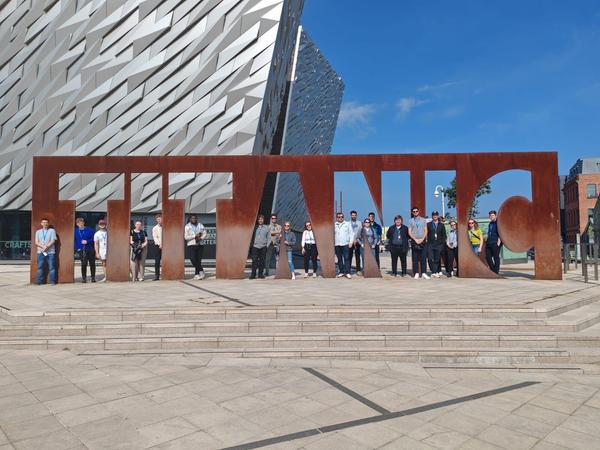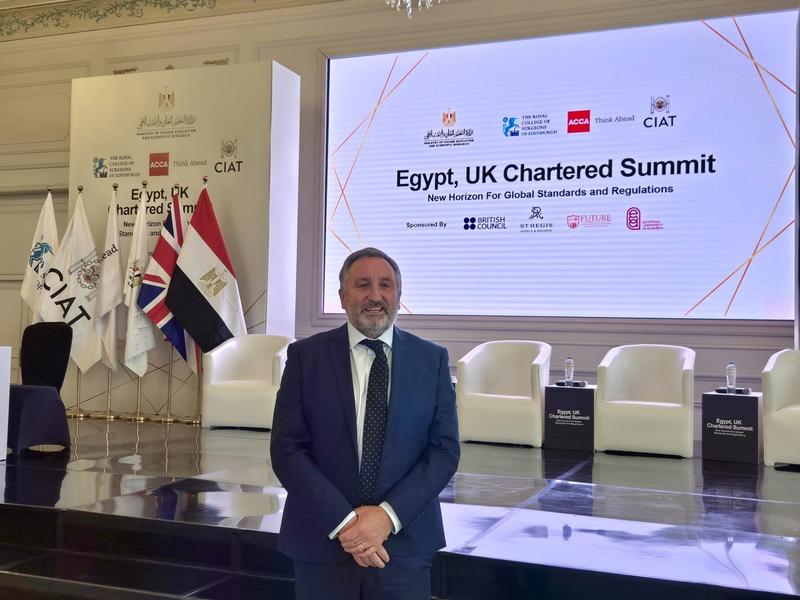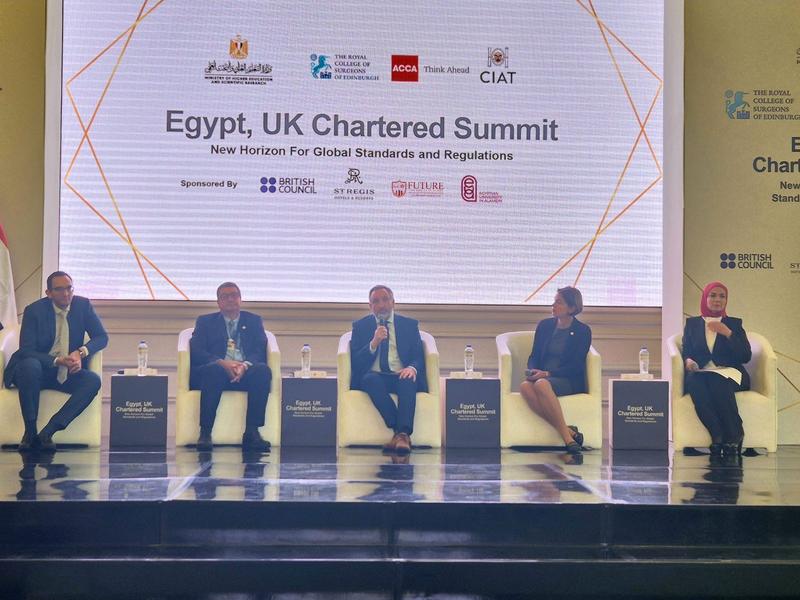Annual Review 2023-24
From the President
As I come to the end of my first year of my second Presidential term, I feel very lucky to be able to represent our membership and our discipline all over again. It was unfortunate that the COVID pandemic curtailed it last time, but it really is a great privilege for me to be able to get involved with all the amazing projects and people that are at the heart of our wonderful AT community.
This Annual Review covers the period November 2023 to November 2024, which has been another hectic and action-packed year, with much work going on behind the scenes, as you will see from the below.
Our next President was elected in September, and I am proud to say it is Usman Yaqub FCIAT who will be leading us into our sixth decade. I'm excited to work with him and our Board and Council to ensure that the Institute remains relevant, inclusive, and the natural home for all those within the AT sphere.
As we approach the Institute's 60th Anniversary next year, there is still much work to be done to ensure that our membership have a voice, to further our recognition, and raise the flag for AT.
Promoting Architectural Technology and protecting its standards
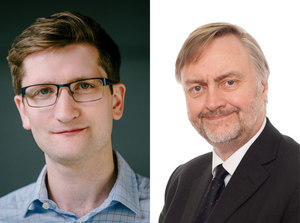
Jack Fleming, Policy & Public Affairs Executive and Mervyn Pilley, Business Development & External Affairs Executive
Public Affairs and Policy
In the run up to the general election, CIAT responded and contributed to the Construction Industry Council (CIC) requests of the new Government (which focused on low carbon and retrofit, building safety, and skills shortages and recognition) and reviewed party manifestos against CIAT priorities.
CIAT set up two new roles this year to form the Policy and External Affairs Team. The Business Development & External Affairs Executive works to establish and strengthen an external affairs presence for the Institute, while the Policy & Public Affairs Executive is focused on benchmarking CIAT's profile in parliament, strategy development, and proactive engagement with key stakeholders. I'm truly delighted to have this new team; our membership will start to notice the real benefit of their work in no time at all.
AT Awards
The AT Awards ceremony took place on 25 October at a new venue: the impressive, Grade I listed Christ Church in Spitalfields, East London. Designed by legendary Baroque architect Nicholas Hawksmoor and consecrated in 1729, its over-sixty-metre spire dominates the skyline of the surrounding high street. It was a fitting place to celebrate excellence in building design and function, especially when you add a bespoke dancefloor in the crypt. The Autumn issue of AT Journal featured the finalists, winners and recipients. All the winners can be found here.
Conduct and Complaint Procedures Review
The Code of Conduct is undergoing a review with the aim of consolidating the three-part Code to maximise transparency and clarity. Consequently, the Conduct and Disciplinary Procedures will be reviewed to ensure they are as straightforward as possible. The Documents Taskforce and Conduct Committee are collaborating to ensure that both documents align with each other.
Further, active engagement with the Architects' Registration Board (ARB) is in progress, which will allow the Institute to access more comprehensive understanding of feedback and recommendations received by ARB relating to its Code of Conduct.
Accreditation and Approval
CIAT's portfolio now consists of 57 Programmes. Steadily building over the last decade (as you can see in the graph below), these include 39 Accredited Honours degree level, 8 Accredited Master's degree level and 10 Approved programmes. The Institute also has 3 Centres of Excellence: educational establishments that run both an Accredited Honours and a Master's Programme, and have a robust culture of research and knowledge exchange that has a significant impact on and contribution to the evolution of Architectural Technology.

Apprenticeships
This year, CIAT has been keeping a watching brief on the Labour Party's plans to broaden the existing apprenticeship levy into a growth and skills levy. This will allow firms to use up to 50% of their levy contributions to fund training through routes other than apprenticeships.
Professional Standards Framework (PSF) Review
This year, the Professional Standards Framework (PSF) was revised and will now be known as the Professional Standards Competency Framework (PSCF) in line with external changes, to verify competency and be explicit on building safety. The new 2025 PSCF will be published in the New Year. Associate members and affiliates have four months to decide whether they wish to qualify as Chartered Architectural Technologists under the 2015 version of the PSF or the 2025 PSCF version.
Applications to qualify through the 2015 PSF will be accepted until 30 April 2025 and applications using the 2025 PSCF will be accepted from 1 May 2025.
CIAT's Architects' Registration Board Education Reforms Working Group
The Institute this year set up a working group in response to the Architects' Registration Board (ARB) proceeding with its plans to only accredit Master's level education and practical training from September 2027 onwards, which may have an impact on ATs and the Institute.
The Working Group consists of Chartered Architectural Technologists from both academia and industry. Its remit monitors the situation and develops CIAT's position as we learn more about these reforms and their potential repercussions. We continue to engage with ARB throughout this process.
Consultations
The Institute has responded to six consultations in the past twelve months, including the National Planning Policy Framework (NPPF) and net zero carbon across the home nations.
In April, we made members and affiliates aware of the ARB's independent Commission, which made a call for evidence relating to professional practical experience in architecture for students. The findings will be published by the end of this year.

In September, the Construction Industry Council's (CIC) Climate Change Committee (Workstream 10) launched a consultation on a draft competence framework for sustainability in the built environment that was worked on with the Edge think tank and the University College for Estate Management (UCEM), as well as an industry-wide Advisory Panel, and is anticipated to become a British Standard. CIAT provided comments on this draft as part of the consultation, which closed in mid-November.
If you have an interest in taking part in consultations, please contact the Technical Department on [email protected].
Enhancing the profile of the discipline, the membership and the Institute
Architectural Technologists' Register (ATR)
The objective of the ATR is to facilitate and enable statutory recognition of the AT profession in the Republic of Ireland. Following meetings and communications with the Minister and Department, we have been working to the agreed milestones, which would enable the government to support statutory fruition.
Milestones achieved so far include a functioning admissions and assessment board, with a professional conduct committee and appeals board being formalised. The ATR has demonstrated it is a viable standalone entity with a returned surplus in the 2023/24 period: total of 91 ATR Full Registrants are subscribed and registered.

Discussions have been held with Registration Authorities for Building Surveyors (SCSI) and the Royal Institute of the Architects of Ireland (RIAI) as part of the consultation and research process. The final milestone of a complete second cycle of subscription renewals for 2024/25 has been delivered. Correspondence to this effect was issued to the Minister and Department in late Summer.
The ATR and CIAT Republic of Ireland Centre also had a stand at the National Construction Summit in Dublin in April, which was attended by over 2,000 delegates.
Technical Coordinator
As part of a wider recruitment push, the Institute created the role of Technical Coordinator this year to manage its technical functions, researching, analysing and interpreting industry trends, technical information, policy, legislation and regulations (as they relate to Architectural Technology, the Institute and its membership), ensuring that CIAT's activity aligns with the changing needs of the sector.
Manipal International Symposium on Design (MiSD), Dubai
The Manipal Institute of Higher Education in Dubai, which offers a CIAT Accredited degree, held a hybrid research conference, co-hosted by CIAT and Edinburgh Napier University, a CIAT Centre of Excellence, on 15 and 16 February 2024. The event, titled Architecture and Technology: Preserving the Past and Sustaining the Future, saw Professor Sam Allwinkle PPBIAT FCIAT and Eddie Weir PCIAT give opening speeches.
aspiration
aspiration goes from strength to strength under the rebranded tagline of "nurture, network and develop", after the Head of Creative & Communications took over its management on 1 April.
Members and affiliates are now automatically part of the aspiration community and can choose to be involved as much or as little as they want to be, whether they want to join a formal group or not.
We launched a promotional film for aspiration on 9 May. View it below.
A group of aspiration members attended an educational weekend in Belfast in August, which involved meeting people in practice, learning about the city and networking with peers. The format was a great success and will be repeated in future years.
GOV.UK Regulated Professions Register – Chartered Architectural Technologist
Earlier this year, the Institute was pleased to be invited by GOV.UK to develop their directory listing on the Register of Regulated Professions in relation to the Chartered Architectural Technologist.
The National Self Build & Renovation Centre
CIAT is now included in the 'Professional Services' hub along with a stand which features all aspects of Architectural Technology. Additional promotion and exposure will now follow with the Centre's 'Ask the expert' days and other features.
Aligning, collaborating and partnering
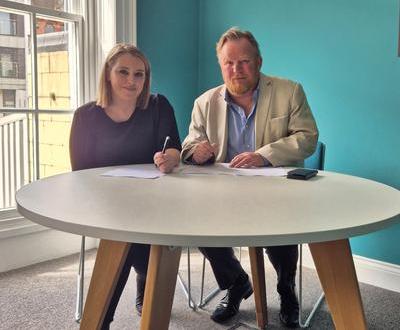
Tara Page, CIAT Chief Executive with Simon Hamlyn, CICES Chief Executive
Chartered Institution of Civil Engineering Surveyors (CICES)
CIAT formally entered into a five-year Collaborative Agreement with the Chartered Institution of Civil Engineering Surveyors (CICES) in April, with the aim of cooperating further on matters in common relating to Architectural Technology and Civil Engineering Surveying. This has extended the dialogue between the two organisations, encouraging them and their respective memberships to collaborate on areas of mutual interest and benefit, such as professional development, conferences, education, member services, and professional services.
We also promote each other, work together on initiatives, share information, and will support and assist each other with lobbying and joint action. The Institute presenting at the CICES Manchester Lecture in February, for example, presenting our new strategic plan and addressing the future of the built environment.
Building a Safer Future (BSF)
In July, CIAT officially became a Corporate Supporter of Building a Safer Future (BSF), an organisation that promotes cultural and behavioural change towards safety in the built environment sector. Originally focusing on high-rise residential buildings in the wake of the Grenfell Tower tragedy, BSF and the Charter has extended its scope to cover buildings of all heights and the construction industry more broadly. As a Corporate Supporter of BSF, CIAT declares its public support of the organisation's principles, and demonstrates their commitment to both putting building safety first and driving change through their UK-wide partner networks.
Building Designers Association of Australia (BDAA)
The Institute and the Building Designers Association of Australia (BDAA) signed a Memorandum of Understanding (MoU) in August that signified a three-year formal agreement between the two bodies to cultivate and promote international relationships. It is a statement of intent that aims to foster genuine and mutually beneficial cooperation, in order to cultivate a relationship of trust based on principles of mutual respect, shared benefits, common interests, aligned objectives, and complementary activities. Together, the organisations have started to work collaboratively for the enhancement of the design and construction industries, strengthening sustainable professional communities, engaging in social innovation initiatives, and developing international partnerships.

The Arc collaboration
The Institute is a founding participant of The Arc, an historic built environment online resource. The Arc is an online resource for clients and stakeholders in the built and historic environment sectors. The Arc's purpose is to help clients find specialist historic environment professionals, including CIAT-Accredited Conservationists. It does this by signposting clients and stakeholders to the registers of the founding participants that contain contact details for accredited or similarly qualified individuals and businesses.
The goal is to help clients and stakeholders make informed decisions when choosing historic environment professionals. It simplifies access to and clarifies the benefits of engaging appropriately qualified and experienced professionals. The other founding participants are Chartered Institute for Archaeologists (CIfA), Chartered Institute of Building (CIOB), and Institute of Conservation (Icon).
The founding participants have agreed to work closely together in the interests of clients, stakeholders and wider industry to promote The Arc alongside their own registers.
Ireland's Department of Further and Higher Education, Research, Innovation and Science (DFHERIS)
The Institute has begun working with the Department of Further and Higher Education, Research, Innovation and Science (DFHERIS) in Ireland on the promotion of careers in the built environment. This included attending WorldSkills 2024 in Dublin in collaboration with other professional bodies. The joint goal is to effectively make known the knowledge and skills required to ensure that homes and other built environment projects can be sustainable and be retrofitted.
Ministry of Higher Education and Scientific Research of Egypt (MoHESR)
In September, the Institute signed a Memorandum of Agreement (MoA) with the MoHESR, the objectives of which are to enhance Architectural Technology education in Egypt by facilitating Accreditation, Approval and CPD certification to Egyptian universities and providers, and to promote CIAT membership progression. MoHESR aims to raise professional standards in Egypt by working with established and respected universities and representative organisations such as CIAT.
The Commonwealth at 75
CIAT was invited as an official editorial partner of The Commonwealth at 75, a commemorative publication produced by The History of Parliament and St James's House, which celebrates examples of leadership, equality, innovation and development between the 56 nation states.
The Commonwealth at 75 was researched and written by a select team of academics and award-winning authors. The fully illustrated publication explores the origins, history and impact of the Commonwealth up to the present day and marks the appointment of King Charles III as the Head of the Commonwealth – a prominent position on the global stage. It also highlights examples of achievement and progress across social, technological, commercial and cultural spheres. The Institute’s double page article on page 452 is entitled ‘Heroes of architecture’ and the President and Chief Executive attended its launch in October 2024.
Providing services for the benefit of members and society
Launch of the Principal Designer (PD) Register
The Institute's PD Register launched on 1 May 2024. Although it is not currently mandatory to be on a Register, Chartered Architectural Technologists will find it advantageous to be able to demonstrate their competence to clients and other duty holders through the publicly available Register.
Applicants can choose to apply to have their competence assessed as a PD for non-Higher-Risk Buildings (non-HRBs) as well as for Higher-Risk Buildings (HRBs). Those that are accepted onto the Register for HRBs will receive dual registration onto CIAT's non-HRB Register as well. More information can be found here.
Frequently Asked Questions (FAQs) on the website have been consistently reviewed and updated to ensure the provision of current information. As a result of queries that have been received, the Practice and Technical Department is in the process of developing additional information sheets that will highlight the key distinctions between HRB, non-HRB, and domestic non-HRB scenarios.
Since the publication of the Building Safety Act 2022 and Building Regulations (Amendment) (England) Regulations 2023, currently, and in collaboration between Documents Taskforce and Liability Taskforce, Agreements for Commercial Projects and Agreements for Domestic Projects are undergoing review to align with legislation and delineate Principal Designer roles.
Since May, it has been encouraging to see all those coming through and demonstrating their competence further.
AT CPD Register and Catalogue
The AT CPD Register now has 16 providers offering 66 courses on topics ranging from BIM, CDM, fire, conservation, timber technology, asbestos management, insulation, contract awareness, leadership and professional development, off-site construction and zero carbon.
The CPD Catalogue continues to host the recorded events arranged by the Region, Centre and aspiration Groups as well as other relevant resources for the benefit of members and affiliates, though this content has not been assessed by the Institute.
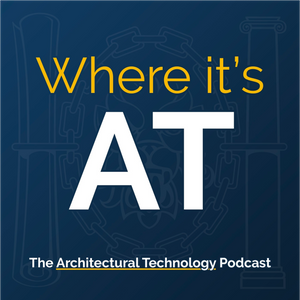
Where it's AT: The Podcast
The podcast series was launched in August. Each 30-50 minute episode is available from all leading platforms that support podcasts. The podcast launched with an episode on the Principal Designer Register, Professor Sam Allwinkle and the Head of Membership presenting. Other episodes in the series include Ann Vanner FCIAT looking at whether your home is killing you, The Golden Thread panel discussion recorded at Futurebuild, and a discussion between a former Student Award winner and his mentor Alex Naraian PPCIAT MCIAT.
Publications Executive
As part of this year's increase in staff numbers to ensure the membership's needs are met, the new role of Publications Executive was created as part of the Creative & Communications Department. The Publications Executive manages, develops and edits CIAT's publications and documents, including the Architectural Technology Journal, press releases, and copy for the AT Awards.
Refinement of Honorary Fellow (HonFCIAT) accolade
The information on how to nominate an individual for Honorary Fellow, HonFCIAT, has been refined and updated.
Honorary Fellow, HonFCIAT, is awarded to an individual who is eminent in their field, and whose work has had a positive impact on Architectural Technology; and/or for their significant contribution to and/or excellence in Architectural Technology. Honorary Fellow is by nomination only and cannot be applied for; individuals must ve nominated in confidence and nominations will be considered by the Honorary Fellow Panel.
Nominations are made by completing the nomination form which includes a written citation of no more than 1,650 words, based on the candidate's positive impact on, significant contribution to and/or excellence in Architectural Technology, and must clearly demonstrate the candidate's suitability against the Honorary Fellow criteria. Current members or affiliates of the Institute are not eligible for nomination, and in the interests of transparency and impartiality, staff and serving Honorary Fellow Panel members are not eligible to make nominations or write citations.
If you require factual/historical information about the person you are nominating in relation to CIAT, please contact Adam Endacott, Head of Creative & Communications ([email protected]) who will endeavour to provide the information you seek. Full information and guidance can be found here.
The Affiliate Group Body Corporate (AGBC) scheme
The scheme invites corporations to further engage with the Institute and support the discipline, and continues to go from strength to strength, with the total numbers doubling year on year. You can find out more information on the scheme here.
BSI
The Practice and Technical Department has worked with BSI to enable members to access standards through a tailored membership that provides unlimited, full text view-only, access to 90,000+ British, European, and International Standards on the BSI Knowledge digital library for £360/year (plus VAT). The qualifying criteria for this new BSI Membership tailored for micro-businesses is a turnover of £632,000 or less, £316,000 or less on its balance sheet, 10 employees or less.
For those who qualify and have an interest to apply, please contact the Technical Department on [email protected].
Taskforces and Societies
The Technical Department relaunched its Documents Taskforce and Liability Taskforce this year. The ongoing work includes reviewing and updating its documents and information sheets to ensure currency.
In July 2024, the Institute launched the Digital and Climate Change Society. Societies are intra-Institute networks for the exchange of views, knowledge, and insights in relation to facets of Architectural Technology. These groups are being established by CIAT as "homework sharing clubs", to prevent other members and affiliates from making mistakes that have already been made as well as de-risking their attempt to adopt at innovative ways of working.
Recruitment for Taskforces is ongoing, and you can learn more here.
Membership Engagement Project
This project began this year with the purpose of understanding the needs of members and affiliates (existing and potential) and ensure they are met, in order to both effectively promote the Institute's value proposition and to communicate and engage with all stakeholders.
Activity has so far concentrated on creating and sending surveys to capture initial data from our stakeholders, the results of which are currently being analysed for the next step of the project in 2025.

Region and Centre Review
The Region and Centre Review was launched to analyse the structure and functions of the Regions and Centres to ensure they remain relevant and accessible to all current and potential members and affiliates, and to allow for transparency, continuity and succession.
Detailed analysis of consultation responses and determination of next steps is ongoing, and following feedback from Council regarding timescales and the need for a comprehensive consultation exercise, the project completion date is to be determined post-consultation.
Remaining an effective and financially viable Institute




